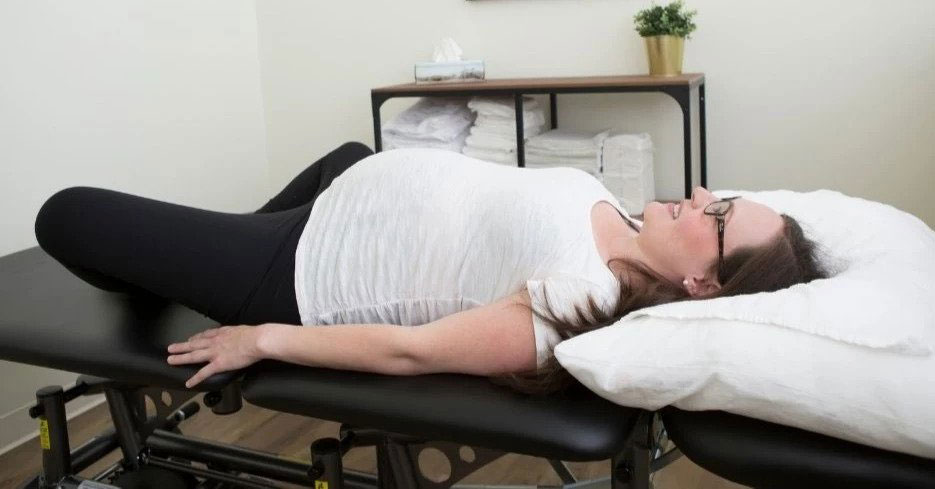So… you’ve been told to see a pelvic floor physiotherapist, what comes next?
Whether it was because your girlfriend raved about her experience, a suggestion you heard in a prenatal class, or based on your doctor’s recommendations, you are now on the hunt for a pelvic floor physio.
But what exactly is a Pelvic Floor physio, how are they different from any other physio and what can you expect at your very first pelvic floor physio visit? SO. MANY. QUESTIONS!
Many of us will turn to the internet for help, because you’re not only wondering what the Pelvic Floor is, but how (and what) a physio assessment could include “down there”. From what you can see on Google Images, the pelvic floor is inside the pelvis, so how does a physio assess…that?!
In today’s blog post, we’re going to break down what you can expect on your initial assessment, starting with …
Step 1: Discovering your Subjective History
After some friendly chit chat, the first thing your physiotherapist will do is go through your history. We want to know your WHY. Typically, you will be asked questions related to your present concern and reason for your visit, as well as your medical history, medications, and history of other injuries.
In Pelvic Health, we may also ask you questions around more intimate areas of your life including:
- Bladder and bowel function
- Sexual function
- Menstrual health
- Obstetric history
Please know that we only ask these questions because we want to help you, and they are relevant in understanding your concerns. Please only share what you are comfortable with, just know the more information and insight you can provide, the better equipped we are to help.
Your physiotherapist will then ask you about your specific goals you hope to achieve through treatment This ensures each session is directed toward your goals and milestones you want to achieve along the way.
Step 2: Undertaking an Objective Assessment
Once your physiotherapist has asked you more questions than you thought possible, you will then move onto the objective or physical assessment. What will be assessed or looked at with/by your physiotherapist will largely depend on your primary concern and symptoms you are experiencing.
Here are some common examples of what your physiotherapist may look at:
- Posture – This may include standing, sitting, and posture with movements
- Gait – The way we ambulate and carry our bodies during the day can have significant impacts on the way our body feels. This can be an important thing to assess to identify if our movement patterns are contributing to your symptom experience
- Functional Movements/ Activities of Daily Living – If your symptoms are exacerbated with specific movements or activities during the day, your physiotherapist may want to examine these more closely and adjust how you perform them so that they may contribute less to your symptoms
- Low Back and Hip Movements – Research shows a correlation between pelvic floor dysfunction and lumbopelvic pain
- Muscle Strength and Length – External muscles that are weak and/or tight can contribute to your pelvic floor function and overall movement mechanics. And sometimes, the issue may not be originating from your pelvis but a different area of the body!
- Abdominal Function – This can include an assessment for Diastasis Recti, Abdominal Pressure Management, and/or Core Strength
It’s important to note that Pelvic Floor physical therapy extends BEYOND the pelvic region. It often requires a whole body assessment and approach to care.
Step 3: The Internal Assessment
We have now reached the part of the assessment where we start to look inward. Our Pelvic Floor is an internal set of muscles, so the best way for us to assess their function is with an internal exam.
An internal Pelvic exam is the gold standard to assess your Pelvic Floor muscle function and connective tissue internally and may be suggested by the physiotherapist based on the concern of the client. This is where clients can become nervous, anxious or apprehensive.
Please know, we are here to support you through the process, and that an internal assessment is never mandatory and would only be performed with your informed consent. Consent can be revoked at any time, no matter how far along you are through the assessment.
If an internal Pelvic Floor assessment is recommended for your symptoms, your physiotherapist will discuss this assessment with you in detail including what the assessment would entail in a step by step manner. This internal assessment could be performed vaginally, rectally, or both depending on your area of concern.

If you consent to an internal assessment, your physiotherapist will leave the room while you get undressed from the waist down.
What happens next …
🍉 You would lie on the treatment bed and have a sheet to cover up your lower body.
🍉 Once you are ready your physiotherapist will come back in and begin the assessment using a clean technique with non-latex gloves.
🍉 Externally, the physiotherapist will assess your tissue on the outside of the pelvis. They may also teach you how to perform a kegel (or pelvic floor muscle contraction) with the proper breathing technique at this time.
🍉 Afterwards, they will assess the muscles and tissue internally, either vaginally with 1 or 2 fingers inserted, or rectally with 1 finger. This will allow the physiotherapist to assess your muscles from the front, back, and on the sides of the pelvis.
🍉 Lastly, your pelvic floor strength, endurance, tension, coordination, muscle activation patterns and tissue laxity will be assessed.
Your physiotherapist will then be able to test your Pelvic Floor function as accurately as possible, and create a treatment plan based on both your subjective and objective findings.
Step 4: Education & Home Exercise Program
Based on your objective assessment, your physiotherapist will provide you with some information and education to give insight into your symptoms and what may be causing them. This can include information on your physical anatomy, including how your muscle, connective tissue, organs, and bony anatomy may be contributing to your concerns.
The physiotherapist may also discuss behaviors or habits that you are performing during the day and how to optimize those to improve symptoms. This education is intended to help clients better understand what they are experiencing, how their current function and movement patterns are helping or hindering them, and what they can start doing at home to improve this.
Additionally, clients will typically be given exercises to begin addressing the things that are contributing to their symptoms, which can include breathing, stretching, strengthening, and release techniques.
Step 5: Designing Your Treatment plan
Once you and your physiotherapist have completed all necessary assessments, the remainder of the session will be used to develop and discuss your individualized treatment plan going forward.
This can include:
- Recommended treatment techniques
- Frequency of sessions
- Total number of sessions
- Length of time it will take to get better
- At home exercise program, active rehabilitation referral or any other health care providers you might benefit from including on your team
- Product recommendations
This may change based on how treatment progresses, but you should leave your session with a clear understanding of the plan moving forward with your physiotherapist.
At Bump Physio we emphasize the importance of establishing strong therapeutic relationships with our clients.
Once you step out of the clinic door after your first session, you should leave feeling that you were able to connect to your physiotherapist, that you were able to share your story and experiences, and that your physiotherapist listened with empathy and respect.
It is our utmost priority that every client feels seen and heard, and leaves the clinic with a better understanding of their symptoms and a plan they created with the physiotherapist to address their concerns.
Savanna Rowe, MPT
🍉 Registered Interim Physiotherapist
Citations
Bo, K. Sherburn, M. Evaluation of female pelvic floor muscle function and strength. Physical Therapy. 2005. 85(3):269-282.
Dufour, S., Vandyken, B., Forget, M.J., Vandyken, C. Association between lumbopelvic pain and pelvic floor dysfunction in women: A cross sectional study. Musculoskelet Sci Pract. 2018. 34:47-53. doi: 10.1016/j.msksp.2017.12.001.
